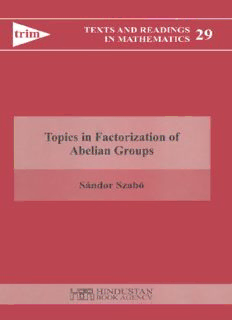Table Of Content29
TEXTS AND READINGS
IN MATHEMATICS
Topics in
Factorization of Abelian Groups
Texts and Readings in Mathematics
Advisory Editor
C. S. Seshadri, Chennai Mathematical Inst., Chennai.
Managing Editor
Rajendra Bhatia, Indian Statistical Inst., New Delhi.
Editors
V. S. Borkar, Tata Inst. of Fundamental Research, Mumbai.
Probal Chaudhuri, Indian Statistical Inst., Kolkata.
R. L. Karandikar, Indian Statistical Inst., New Delhi.
M. Ram Murty, Queen's University, Kingston.
C. Musili, Vignan School of Sciences, Hyderabad.
V. S. Sunder, Inst. of Mathematical Sciences, Chennai.
M. Vanninathan, TIFR Centre, Bangalore.
T. N. Venkataramana, Tata Inst. of Fundamental Research, Mumbai.
Topics in
Factorization of Abelian Groups
Sandor Szab6
Institute of Mathematics and Informatics
Pees, Hungary
!l:::[g1Jgl HINDUST AN
llli
U UBOOKAGENCY
Published by
Hindustan Book Agency (India)
P 19 Green Park Extension
New Delhi 110 016
India
email: [email protected]
http://www.hindbook.com
ISBN 978-81-85931-48-7 ISBN 978-93-86279-22-4 (eBook)
DOI 10.1007/978-93-86279-22-4
Copyright © 2004 by Hindustan Book Agency (India)
No part of the material protected by this copyright notice may be reproduced
or utilized in any form or by any means, electronic or mechanical, including
photocopying, recording or by any information storage and retrieval system,
without written permission from the copyright owner, who has also the sole
right to grant licences for translation into other languages and publication
thereof.
All export rights for this edition vest exclusively with Hindustan Book Agency
(India). Unauthorized export is a violation of Copyright Law and is subject
to legal action.
Produced from camera ready copy supplied by the Author.
ISBN 81-85931-48-8
Preface
This volume contains an exposition of the factorization theory of
abelian groups, some of its applications together with the neces-
sary background materials. In 1941, G. Hajas solved a long stand-
ing geometric conjecture of H. Minkowski. This was the first, and
indeed dramatic, illustration that considering a decomposition of
an abelian group into a direct product of its subsets is a fruitful
activity. In the ensuing decades the field grew to such an extent
that it became imperative, in order to enhance further progress,
to make accessible the most important techniques and results in a
unified, simplified, and systematic manner.
Beginners can profitably read Chapters 1, and 2 and various
later sections as a text book. These parts of the book can also be
used as a reading material in a course on applications of abstract
algebra. The experienced mathematician with interest in the ap-
plications of the factorization theory will find Chapters 3, and 11
particularly useful. The specialists of the field can use the volume
as a reference book.
There are exercises throughout the book. These are mainly
designed for beginners. The intent is to slow down the reader and
ask for a few lines of computations, work out details in examples
and fill in gaps in arguments.
The needs of the applications created and shaped the factor-
ization theory in the past. Hopefully in the future it will be stim-
ulated by newer and newer applications. However, we included
some problems to try to point out directions in future research.
vi
Thus the problems are open problems.
Equations and tables are never referred from a different sec-
tion than the one they appear. From this reason equations and
tables are numbered by a single number. Other numbered items
for example theorems are numbered by three numbers. The first
one indicates the chapter, the second one refers to the section it
appears.
Special thanks go to professors Keresztely Cornidi, Emil Molmir,
Arthur D. Sands, and Sherman K. Stein. (The order is alphabet-
ical.) I had the privilege and good fortune to learn from them.
Contents
1 Haj6s's and Redei's theorems 1
1.1 Introduction....... 1
1.2 Simulated factorizations 10
1.3 Rajas's theorem .. 19
1.4 Redei's theorem .. 29
1.5 Keller's conjecture 37
2 Elementary arguments 46
2.1 An axiomatic approach. 46
2.2 Direct product ..... 55
2.3 Nonperiodic factorizations 66
3 The machinery 78
3.1 Vanishing sums 78
3.2 Annihilators. 90
3.3 Zero divisors 106
4 Four characterization results 119
4.1 Nonsubgroup factors ... . 119
4.2 Multiple factorizations .. . 126
4.3 Multiple cyclic factorizations 133
4.4 Robinson's result . . . 145
5 Applying the machinery 164
5.1 Size of annihilators .. 164
CONTENTS
Vlll
5.2 Cyclic type subsets 175
5.3 Simulated subsets. 185
5.4 Periodic subsets .. 196
6 Cyclic prime component 205
6.1 Cyclic prime component 205
6.2 Cyclic groups . . . . . . 211
6.3 Nonperiodic factorizations 216
6.4 Simulated subsets. 224
7 p-groups 234
7.1 Groups of order p4 234
7.2 Factoring 2-groups 244
7.3 Nonperiodic factorizations 262
7.4 Elementary 2-component . 269
8 The Haj6s property 287
8.1 Groups without Rajas property 287
8.2 Groups with Rajas property . 296
9 The Redei property 311
9.1 Latin squares ... 311
9.2 The Redei property .. 321
9.3 Groups with Redei property. 337
10 Infinite groups 352
10.1 Infinite constructions. 352
10.2 Infinite abelian groups 360
11 Further topics 373
11.1 Some applications 373
11.2 Miscellaneous results 385
A Simulated subsets 395
B Haj6s's theorem 400
CONTENTS
IX
C Redei's theorem 406
D Background of constructions 411
E Cyclotomic polynomials 419
References 425

